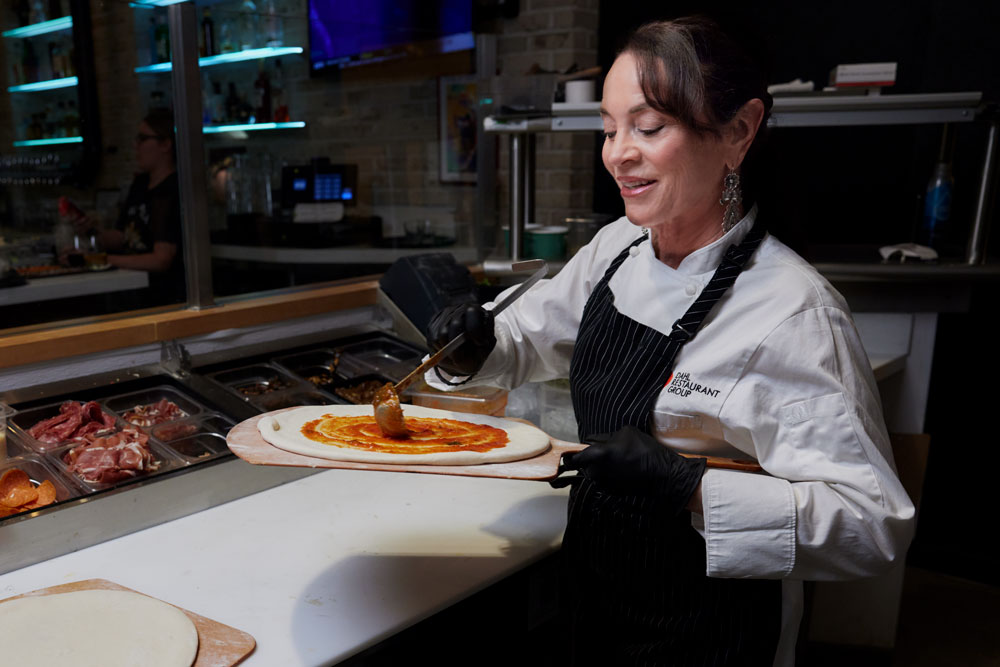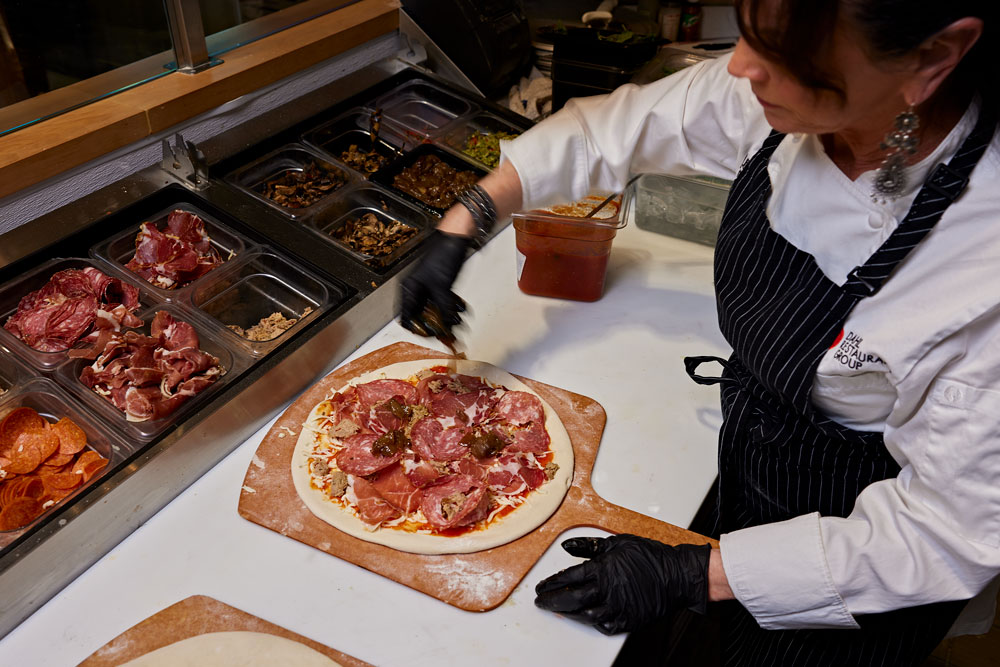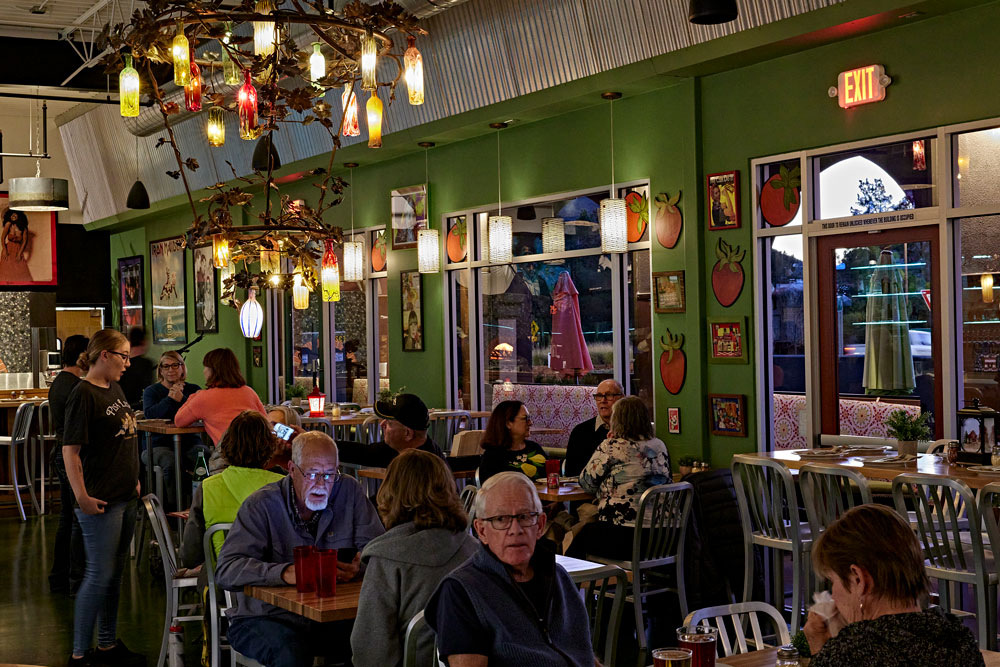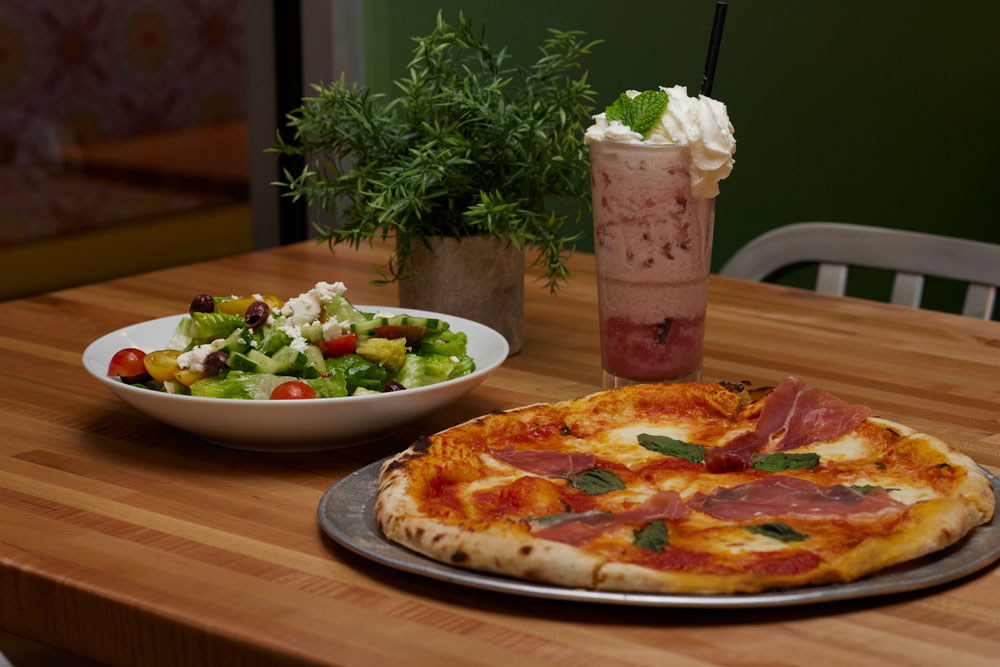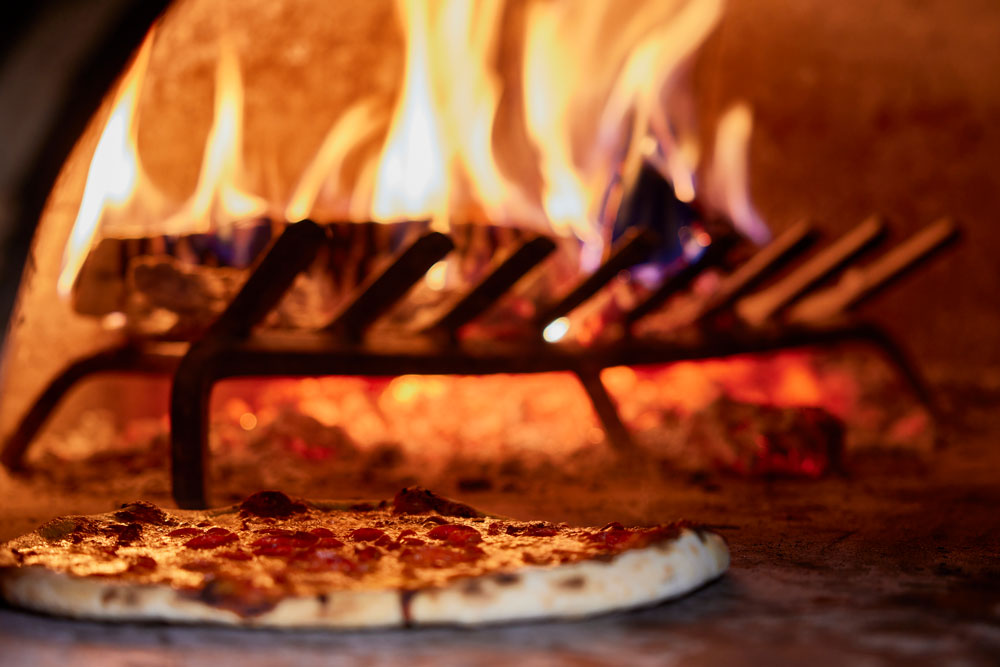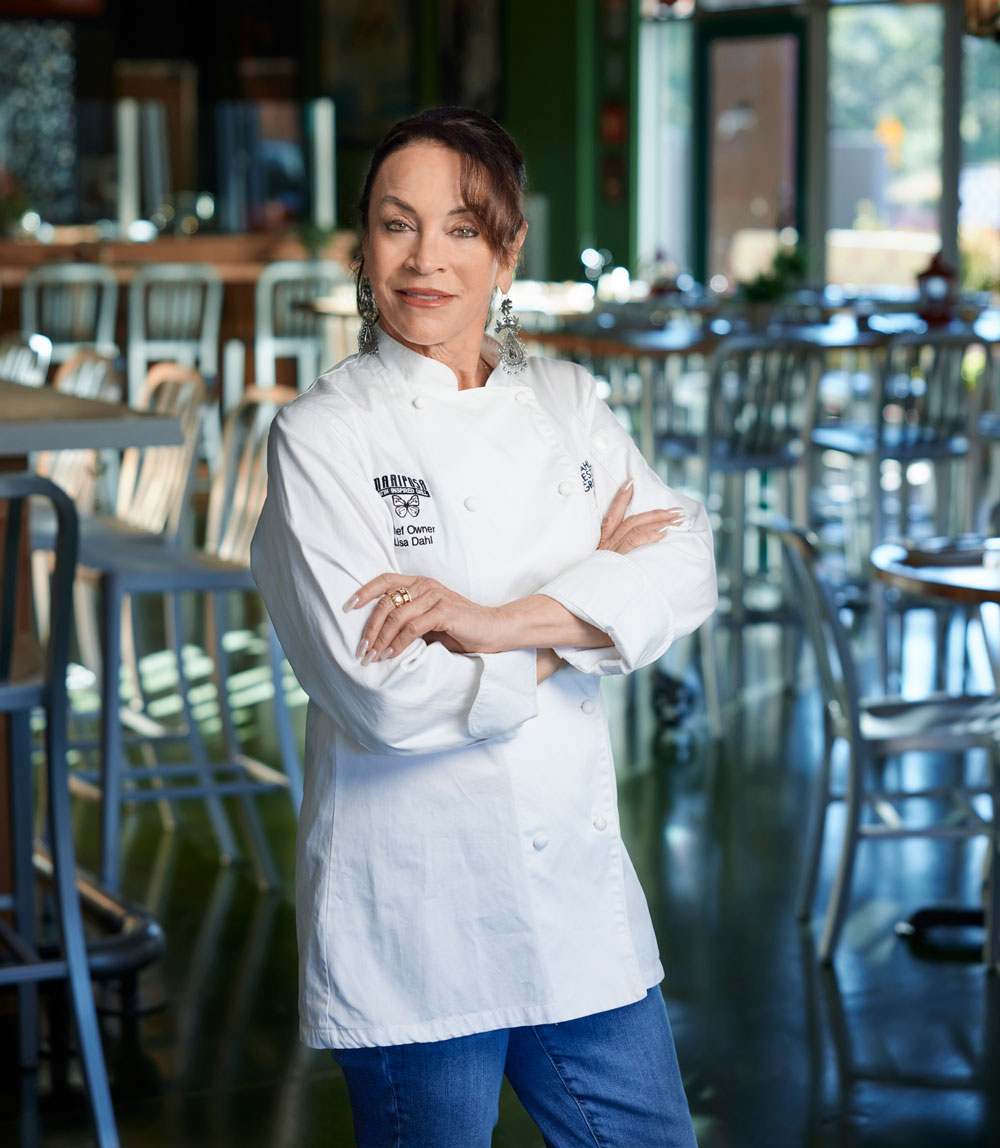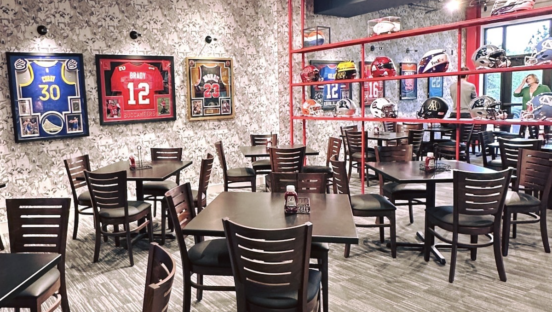- After the tragic loss of her son, Lisa Dahl transformed herself into a restaurant owner and self-taught chef. Now she’s the culinary queen of Sedona, Arizona.
- Dahl turned a former Pizza Hut into her first Pisa Lisa store and, despite some setbacks, hit the $1 million revenue mark in her first year.
Story By Tracy Morin | Photos by Scott Yates
Once dubbed “the culinary queen of Sedona,” Lisa Dahl strikes a commanding physical presence, at ease holding court before her hordes of admirers, customers and employees alike. With a former career in fashion retail, she’s also forever impeccably dressed, not a hair out of place—as if she were not juggling five different restaurant concepts in an obsessively hands-on manner; 380-plus staff members as the largest employer in Sedona, Arizona; a publishing career, with two cookbook memoirs under her belt; and constant recipe innovation as the executive chef, owner and CEO of Dahl Restaurant Group. We can only ask, what’s her secret?
“Umm….” She pauses to think. “Being fanatical?”
A Fresh Start
Dahl, born into a fashion-business family (her mother was also an entrepreneur), started her career in retail and wholesale in the San Francisco Bay area, and she always had a passion for making people happy. “I’d worked in restaurants in high school and always loved it, but I made my career in boutiques,” she recalls. “I decided to make the culinary business my career after the tragic loss of my son, who was killed in a robbery. I was guided to Sedona to start my life over—to get perspective, change my environment. Within one year, someone offered me a location to buy.”
Today, Dahl’s son, Justin, literally looks over every one of her locations—each features a dedicated shrine to the handsome young man, dishes are named in his honor, and his oversize portrait graces her most dramatic concept, Mariposa. (The word mariposa, Spanish for “butterfly,” celebrates the potential for rebirth and transformation; it’s a uniting symbol on everything from in-house art pieces to chef’s coats at her locations.)
But before all of that fell into place, Dahl had to transform herself, single-handedly, into a restaurant owner and self-taught chef. She bought the location with her then-partner and opened Dahl & DiLuca in 1995—still thriving today. “I was not a professional chef, but growing up in the Midwest I always had an interest in healthy eating,” she explains. “In Indianapolis, in my 20s, I made vegetarian specialties for a health food restaurant, and every day they would sell out. At Dahl & DiLuca, my boyfriend was the executive chef, and I was the sous chef. People started falling in love with our food, and I haven’t really looked back.” At the time, Dahl recalls, Sedona was known for hikes and massages, not fine dining—but her concept launched a revolution to explode that perception.
Related: Women in Pizza: How pizzaiolas are shaping the industry’s future
Growing Pains
With a focus on “making great food and making people happy,” Dahl & DiLuca soon became the place to go in Sedona. Nine years later, an opportunity arose to repeat the feat when she was approached with a location in a then-undeveloped area, the village of Oak Creek—smartly positioned just south of Sedona, making it a gateway of sorts for visitors and already studded with sprawling resorts and sweeping red-rock views.
Dahl jumped on the chance and opened Cucina Rustica, defined by its rustic takes on Italian and Mediterranean dishes. “People thought I was crazy, opening in that part of town—they thought I would fail,” Dahl remembers. “But it was one of the prettiest parts of Sedona. Why wouldn’t people love it? We took a big risk. I don’t think there were any restaurants there yet, but I felt locals would support it.”
Dahl had to build the concept from scratch, working in an existing plaza but in a space that had never held a restaurant. Thanks to her fashion-maven’s eye, she revels in design and crafted a huge, open-space feel that evokes a sprawling Italian villa—perfect for large groups, parties and events—with a menu featuring Dahl’s interpretation of classic dishes. Soon, just like with Dahl & DiLuca, Cucina Rustica was the place to celebrate special occasions in Sedona.
“We had a lot of challenges. We started with a bang and had some hiccups. The product was delicious, but we weren’t knowledgeable about the pizza business, per se. It was very humbling.”
— Lisa Dahl, Pisa Lisa
But with growth came friction. Dahl and her partner were no longer on the same page when it came to vision and growth strategy. As would often be the case throughout her life, hardship opened the door for new opportunity. “I was able to find the freedom I wanted,” Dahl says. “It was hard to finance buying him out, but without that, I couldn’t have opened my first pizzeria.”
She’s also right at home amid Sedona’s mystical-leaning philosophies. “I mean, we were Leo and Aquarius,” she sighs. “We just weren’t aligned.”
Related: 550 Pizzeria’s Janet Duran took a leap of faith – and keeps soaring.
Her pizzeria, Pisa Lisa, set up shop in a humble spot, a former Pizza Hut on a major route in West Sedona. She had always wanted to try wood-fired pizzas, so she purchased the smallest Mugnaini oven she could find, with five-pie capacity, to get started. But this concept didn’t quite enjoy the immediate smash success Dahl had come to expect. “I’ll be honest: We had a lot of challenges,” she says. “We started with a bang and had some hiccups. The product was delicious, but we weren’t knowledgeable about the pizza business, per se. It was very humbling. What we thought we mastered in fine dining was different in the fast-casual/pizza arena. I was worried. We faltered that first year.”
“People love a view….But I thought most restaurants with views were not great restaurants, and that was the last thing I was interested in. I made the food my focal point.”
— Lisa Dahl, Pisa Lisa
Divine Intervention
Dahl points to some “spiritual and business epiphanies” that helped turn around her “tanking” 2,500-square-foot business. Despite a lack of pizzeria knowledge, her strategies led to a strong comeback: On the exact day of Pisa Lisa’s one-year anniversary, revenue officially hit $1 million. “It still gives me goosebumps, because we were close to failing,” Dahl says. “That business became one of my most successful. My financial adviser said, ‘If only you just stuck with pizzerias!’ Mastering the craft of making individual pizzas is something we work on every day, but on paper it looks better than fine dining.”
Indeed, Dahl admits that she chose a very difficult path—it’s easier to create one scalable concept versus juggling five different ones, each with its own personality and unique needs. But if anyone can do it, it’s the tireless Dahl. In 2016, she added another concept in Mariposa, a Latin-inspired grill featuring floor-to-ceiling windows and spacious outdoor patios with jaw-dropping views of Sedona’s famous red rocks. “That’s the big kahuna—an overnight success that truly took on a life of its own before we knew what hit us,” she says. “People love a view, let’s face it. But I thought most restaurants with views were not great restaurants, and that was the last thing I was interested in. I made the food my focal point.”
Mariposa has remained both the most rewarding and challenging of Dahl’s concepts, bringing the highest highs and lowest lows thanks to its massive square footage, bedecked with rusted metals and natural stonework to meld seamlessly with the landscape. But Dahl wasn’t yet done. Pre-pandemic, she set her sights back in the village of Oak Creek. “I had this idea of coming back out to no-man’s land,” Dahl says. “There was an old, tired plaza with an outlet store and not a lot of curb appeal. But I saw that it’s one of the first buildings you see as you drive toward Sedona. I pictured Butterfly Burger and Pisa Lisa there as two anchors in the plaza’s corner locations. I thought they’d be open within six months of each other, but we had no way of knowing the pandemic was coming.”
Butterfly Burger—a concept with gourmet burgers, shakes and salads in a drop-dead sexy, lounge-like atmosphere—managed to clear $2.2 million its first year, despite being open for just six months when the pandemic struck. But Pisa Lisa’s second location slowed to a crawl. “Everything changed with the pandemic,” Dahl laments. “We had to let go of 300 out of 340 employees. It was brutal. Pisa Lisa was in the developing and planning stages, and the supply chain and construction delays gave me PTSD. It was a ‘hurry up and wait’ situation. Plus, people would ask me, ‘How are you going to create the energy of the original?’ How would we get that addictive feeling that people love—the feeling that it’s their place?”
Dahl planned for larger volume, installing two wood-fired ovens. Like with the original, her brother outfitted the airy space with rock-and-roll decor throughout. After many impatient inquiries from locals and tourists alike, its doors opened in June 2022. Dahl foresees making it, in addition to a go-to local hangout, a spot for to-go items—a place to sell her own retail goods, like sauces, tomatoes and meatballs, alongside the two cookbook memoirs she penned to share her food stories and recipes: A Romance With Food and The Elixir of Life.
Related: V&M Bistro: This sister act can outperform the men on any culinary stage

A homey, family-like atmosphere keeps locals and visitors flocking to Lisa Dahl’s Pisa Lisa locations.
A Flourishing Family
Dahl admits being “a little concerned” about the possibility of an oncoming recession—after all, she’s been through it before, around 2008, but back then she had only two concepts to worry about. “You have to be cognizant of the ‘what if’ feelings, but I’m more optimistic about pizza than fine dining,” she says. “We’re keeping our fingers crossed and keeping a watchful eye on numbers and labor, which is probably our biggest challenge since the pandemic.”
Dahl has kept Pisa Lisa’s profits robust by offering not just pizza but a full menu, highlighted by creative salads with organic ingredients and housemade dressings, plus a signature tomato soup, tapas plates, homemade desserts, and carefully sourced gelato that transports guests to an Italian street corner. “If everyone orders just pizza, we can’t pay the bills,” Dahl says with a laugh. “It’s important for people to have a full, well-balanced dining experience, and we feature things that people don’t expect in a pizzeria. I also try to cover all dietary needs. The pizza is the star, but everything else goes along with the experience. When you have so much to offer, people want to sit down and share with friends, not just run in and out.”
Indeed, Dahl realized early the importance of human connection in pizzeria positioning. After opening her first Pisa Lisa, she decided to add to the menu an explanation of the name: When she was young, her father used to tease her, “I want a little piece of Lisa,” and in his thick Chicagoan accent, it sounded like Pisa Lisa. She also sourced a plate from Pisa as inspiration for the logo and sign design. “I wanted to connect my dad, who passed away,” Dahl explains. “He was crazy for pizza and would take my mom for pizza dates when they were courting.”
The pizzas, too, are named after family: Da Dorothy and Da Herbie for her mom and dad, Justino for her son. “We’re connected with them even after they’ve crossed over,” Dahl says. “When I heard the order for the POS or called their pizza names, it became like a chant. It made me feel they were still connected and having fun with us. The connection to that family experience and keeping family memories alive—I think that’s the energy behind Pisa Lisa.”
Today, Dahl is eyeing expansion beyond Sedona, seeking investors for potential growth of the Butterfly Burger and Pisa Lisa concepts, which, she believes, would be successful in many markets across Arizona and beyond. “We are poised to be attractive to investors,” she notes. “It’s a perfect concept to be in markets across the country.”
Still, despite so much success now stretching over more than 25 years—and so much still on the horizon—Dahl remains humble. “I don’t feel like it’s an empire,” she says. “It’s a lot of hard work, a lot of sacrifice and a tremendous amount of joy. We built our reputation on being a family business—it’s just that now we’re a large family.”
Bonus Digital Content
Calling in Abundance: 5 Tactics for Success
In addition to her fanatically hands-on approach, Dahl has prioritized various tactics to nail restaurant success:
- Be of service. Is it cold outside and the kids are hungry? Give them soup samples in-store as they wait for takeout. Little proactive touches like this are what create a warm, welcoming environment.
- Put yourself out there. Dahl has competed in Beat Bobby Flay burger challenges—and performed well, landing her in numerous press outlets.
- Strive to improve. “I’m competing with myself,” Dahl notes. “When I won the first round of that Beat Bobby Flay challenge in 2018, I already thought, ‘How can I do better?’ You live and you learn, and you want to get better all the time.”
- Foster community. Host local events, know your employees, give to nonprofits, and commit ‘random acts of pizza’ by gifting front desk workers at local hotels.
- Create a culture of joy. Try to rise to every occasion. This business is a labor of love.

